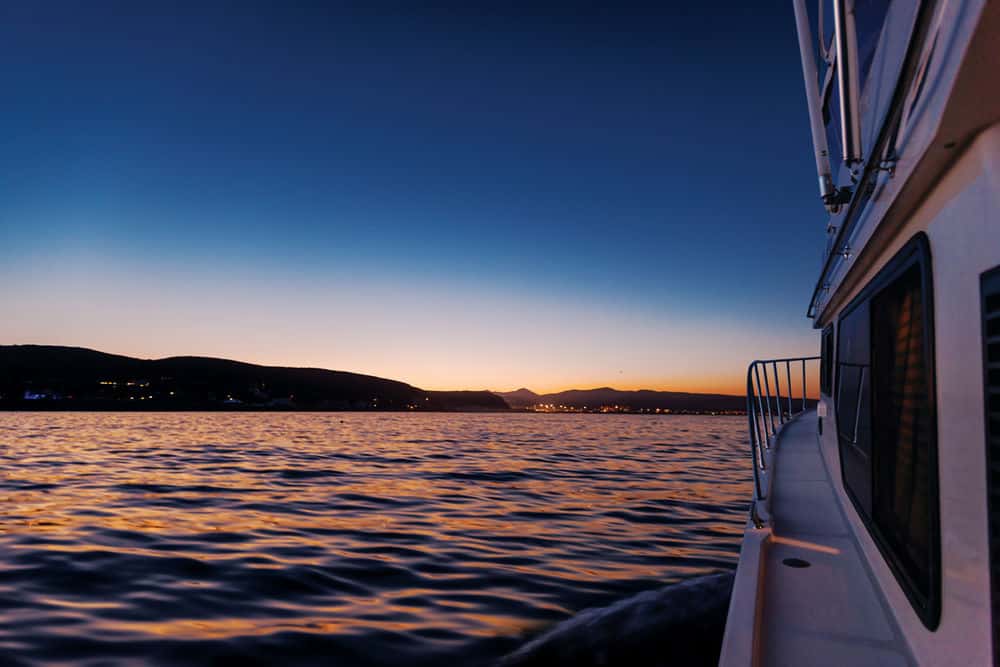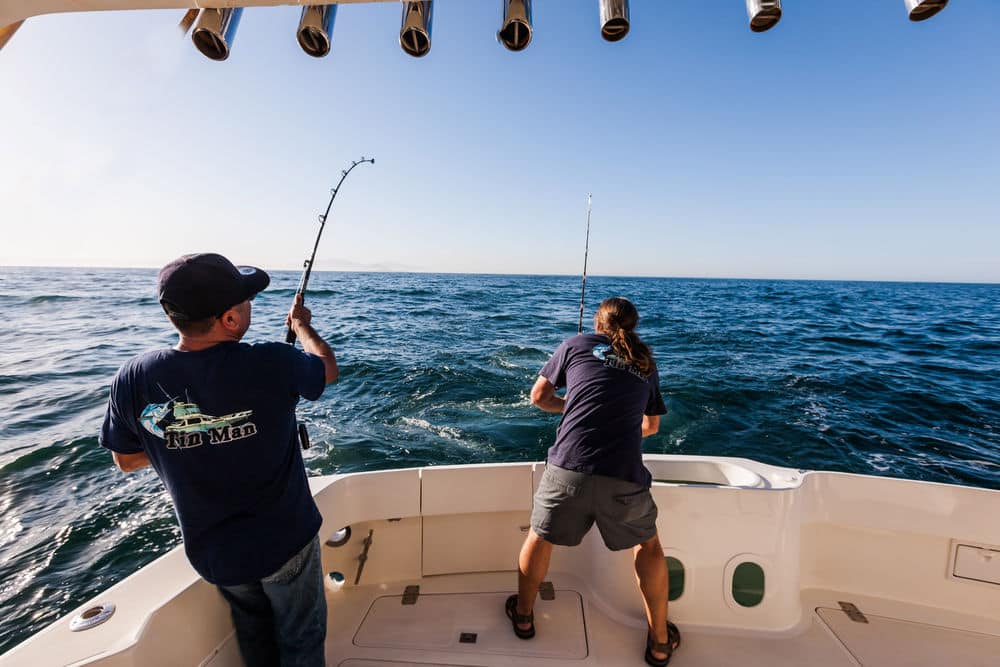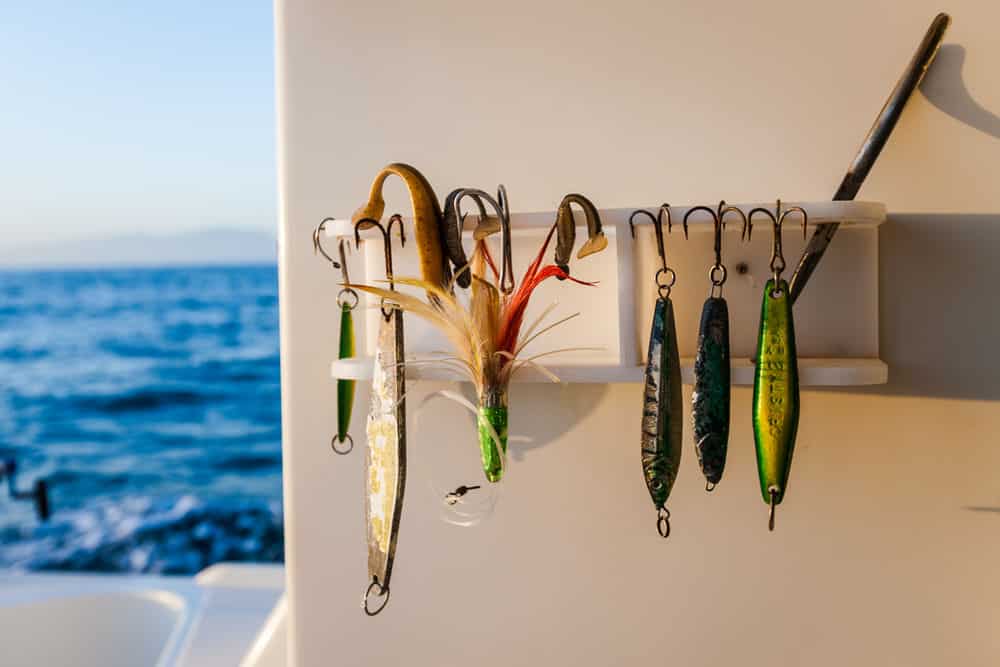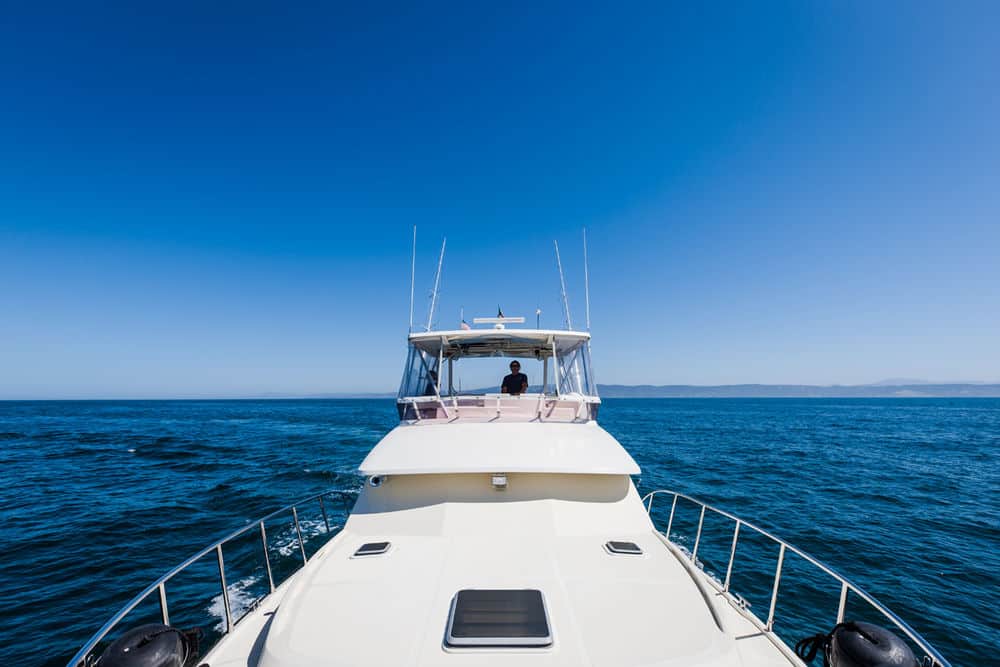
A pale light glowed in the east, and the stars overhead had started to fade. Daybreak wasn’t far away. Still, I couldn’t help casting one final glance at the hotel. If I hustled, I could be back in my warm bed in less than 10 minutes. Instead, I was going fishing. And fishermen like to get up early.
Really early.
At 5 a.m. the dark marina already bustled with activity as 13 boats prepared to cast off the lines. The Hotel Coral & Marina’s friends-and-family fishing tournament was intended to be a low-key affair, but these were serious anglers, and lively competition was in the air.
Aboard the 43-foot Mikelson Tin Man, Capt. Lee Madding and his two-man crew had the coffee pot on and an open box of fresh doughnuts in the galley. Lee got down to business right away. He gave us our safety briefing and gave a quick tour of the boat. He also gave us a warning.
“It’s blowing 15 to 16 knots already,” he advised. “It’s been piping up to 20 to 25 knots in the afternoons, and it could be more, so I want you to be prepared for a rough day.”
I was grateful for this solid battlewagon, because I knew it was designed to handle seas, yet I felt a small surge of apprehensiveness. I’ve spent my life on and around boats, but I am not an angler. I joined this April outing so I could provide firsthand insight into what it’s like to try sport fishing for the first time. Now, faced with 10-plus hours on a cranky Pacific Ocean, I wondered just what I had gotten myself into.

Warming Up
Often called the Cinderella of the Pacific, the Baja California city of Ensenada lies on the Bahía de Todos Santos just 78 miles south of San Diego. This community of 280,000 people is the first major port south of the U.S. border with Mexico; it’s known for world-class sport fishing. In fact, in the mid-20th century, Ensenada was christened the Yellowtail Capital of the World.
Besides California yellowtail, there are opportunities for bluefin, yellowfin and bigeye tuna offshore, as well as striped marlin and mahimahi. Closer in there are calico bass, California halibut, lingcod, Pacific barracuda, rockfish and white sea bass. And lately it’s been better than good.
“The last year of fishing has been amazing,” Lee said as the eastern sky flared apricot and gold. “This month, people have been catching tuna. We’ve had such an influx of warm water near shore, maybe 64 degrees.”
As Lee carefully guided Tin Man northward through the rolling swells, away from what he called the dark and dirty water near shore, crew members Tank and Alejandro prepared the gear. I glanced at the dashboard gauges, noting that the water temperature was 59.32 degrees and climbing. The radio crackled with other reports — 60, 61, 62 degrees — as we approached the dividing line between what the fishermen called “inside” and “outside.” Past Isla Todos Santos, which sits at the outer edge of Bahía de Todos Santos, the seafloor plunges from 225 feet to more than 1,000 feet.
Tin Man wouldn’t go all the way outside. The crew usually doesn’t fish deeper than 300 or 400 feet, because they can’t drop bait on the bottom in an abyss. Adjusting his course to the northwest, Lee pointed toward a flock of wheeling, diving specks.

Fish and Game
If you want to give offshore fishing a try, here are five questions to ask before booking a trip.
How long will we be out there?
If you’re unsure about the experience, plan a half-day outing — you’ll learn about fishing, have some fun and (hopefully) catch fish. If the mission is successful, you can move up to a full-day trip next time.
Inshore or offshore?
For your first trip, especially if you have children, consider fishing along the coast. They’ll be able to see land and will have a blast watching birds and enjoying all the nearshore life and activity. As your family’s comfort level grows, you can discuss options for an offshore adventure.
Charter or party?
Chartering can be expensive. For a first time out, many newbies elect to join what’s called an open party vessel or head boat. These large, comfortable boats seat 40 to 50 people, their crews are trained to work with tourists and first-timers, and you’ll get experience without spending a lot of money. You can buy a one-day fishing license, rent your gear at the dock, spend approximately $50 per person, and see how everyone feels after the trip.
Which boat?
Before you spend money on a charter, make sure you are 100 percent comfortable with the captain and the vessel. Look at reviews online. Ask for referrals. Make sure the boat has a fully licensed crew. When you’re on site, go look at the boat. Ask for a walk-through before any agreement is finalized. If the boat is clean — particularly the galley and head — you’ll know the boat is well cared for.
Is catching guaranteed?
No. There are wild animals involved that don’t care what you paid to catch them. If the fish aren’t biting, just relax and have fun. After all, you’re spending time on the water, and that’s always a good thing.
“See the birds?” Lee asked. “The bottom here is rocky, with pinnacles. The small fish look for bait like pelagic red crabs. Then the big predator fish drive the little ones up, and the birds work that area.”
The disturbance was still a distance away, so Tin Man‘s baitfish remained swimming in the livewell at the transom. For now.
“We use lures when we cover a lot of ground,” Lee said. “We only use baitfish when we know we can drop ’em right on top of the fish we want.”
In the distance, the sea off our port side erupted into a frenzy of splashing, and Lee slightly adjusted his course again. I leaned far out over the rail, trying to see the source of the confusion. An enormous pod of dolphins, 100 members strong, arced and leaped through the heaving sea. I was speechless.
Said Lee simply, “We follow them too.”
A First Taste
Despite two shouts of “you’ve got something,” all we’d managed to land by 8:15 a.m. were two impossibly long tendrils of greenish-brown kelp. Lee suggested we fix some breakfast sandwiches. Some fishermen think, I would learn later, that fish always bite when you’re distracted by food.
We gripped our plates and bottles of water so they wouldn’t tumble onto the floor as Tin Man crested each wave and slid into each trough.
“It’s made for this,” Lee said. “I always wanted a Mikelson. I looked for four years. Then I found this one in Florida in 2012. I had it shipped out here.”
He began restoring it in the summer of 2013, starting with the engines, water pumps and filters. Then Lee added new electronics, transducers, wiring, rod storage and a built-in cockpit live-bait tank. The boat helped Lee fulfill his dream, harbored over the many years he worked in construction in California. Finally, he sold his partial ownership in the company, and today he lives almost full time in Ensenada.
“Living here and going fishing, that’s all I ever wanted to do,” he explained.
Before Lee could say anything else, a shout came from the cockpit. Five adults leaped over each other to reach Alejandro just as a large fish thrashed into view. Alejandro expertly brought it to the rail and gaffed it. A California yellowtail, just shy of 12 pounds, gleamed in the morning sun.
A close relative of the amberjack, the California yellowtail is usually found up to 60 miles from shore, along offshore banks and near islands. Sometimes, you can find them in the shadow of floating mats of kelp (called paddies) or in the break where warm and cold waters meet.
“Blue water means you have a cold upwelling from the depths, rich in plankton and other life,” Lee explained. “Fish like where the warm current meets that blue cold. That’s where they feed.”
While yellowtail love sardines and mackerel, anglers do have success with light metal lures known as “surface iron.” Let the lure sink, and then bring it in at a good clip. Be ready for a quick and powerful strike. Noting that the cockpit can get crowded and rambunctious with a fish on the line, Lee added, “Keep your line pointed straight out from your body. It can get crazy, so if you keep that line straight and follow your fish around, you won’t tangle the others.”
Fishing, Not Catching
The crew brought that yellowtail aboard around 8:40 a.m. For the next six hours, we trolled and we waited. And waited.
“I just saw a yellowtail with his head sticking out of the water, staring at me,” a captain joked on VHF.
“That’s more than I’ve seen today,” another captain piped in with a chuckle. “His gills are flapping because he’s laughing at me.”
Listening to the chatter, Alejandro pointed to two other boats off our stern.
“They think we know something,” Lee announced, grinning. “One thing you do need to remember, though, is that the fishing here is a community,” he continued. “You share your info and your numbers. If you don’t, no one will share with you.”
Surprisingly, the wind dropped in the afternoon and the seas quieted. We circled back toward Isla Todos Santos, which was now to our south, and I marveled that I could see Killers, a famous surfing site where wave faces can reach 60 feet.
Around 3 p.m., a shout rang out. It was a Pacific barracuda this time, a fish that can be easily caught with surface iron, bait and even flies and top-water plugs. Disappointed, I remarked to Lee that it was a shame the sleek, shining fish would have to be thrown back. He stared at me.
“Gringos don’t usually eat them, but they make great ceviche,” he said. This was an eye-opener. I was only familiar with great barracuda off Florida and in the Caribbean. With them, ciguatera poisoning is a real risk.
“Pacific barracuda are 100 percent safe to eat,” said Ken Franke, the president of the San Diego based Sportfishing Association of California. Good to know.
Just 15 minutes later, the shout came again, and it was my turn on the rod. I grabbed the handle and an arrowlike barracuda flipped into the air. With Tank guiding me, I carefully brought the fish toward the railing. Then its lip tore, and it vanished. That wasn’t the end of the action, however. We had company: a sea lion, trolling for a meal off our stern. The crew tried, with no luck, to scare it away.
Before long, it was time to return to the docks for the tournament awards at the Hotel Coral’s Marina Grill. Over margaritas, we learned that our yellowtail (now a plate of fresh sashimi) won second place.
That wasn’t the only prize. I realized how fishing isn’t just about catching. It can be the best way to experience new waters. We reveled in the antics of dolphins, that sea lion and a massive blue whale that came to the surface to blow. We watched the seabirds, listened to the banter on the radio, and felt the swell of the Pacific. Best of all, I lived in the moment, because you’re never quite sure what’s coming next. “That’s the excitement of fishing,” Lee said. “Anything can happen.”

Going to Mexico?
If your family is headed to the Mexican Caribbean, Los Cabos or northern Baja and you would like to give sport fishing a try, make sure you have the following:
Tourist Visa
This isn’t a big deal. You automatically get this if you fly into Mexico, and you obtain one at the immigration office if you’re driving across the border. Tourist visas are good for 180 days.
Fishing License
Every person on your boat must have a Mexican fishing license, regardless of age or whether they’re fishing. We purchased ours at the hotel the day before our fishing trip. You also can arrange to get your license prior to your vacation. Visit sportfishinginmexico.com or bestbajafishing.com for details; if you’re headed to Los Cabos in Baja California Sur, visit bajasursportfishing.com.
Documentation
If you’re driving your car — or trailering your own boat — into Mexico, you must have the proper documents in order. The same is true if you’re arriving by water. Visit mexonline.com/boatmex and mexonline.com/drivemex to learn more. An important footnote: Whether you’re driving your own vehicle or a rental car, you must have a short-term Mexican insurance policy. While your U.S. auto insurance might cover you south of the border, Mexican authorities do not recognize U.S. coverage, and so you are legally required to have Mexican insurance. Check your boat insurance policy too.








